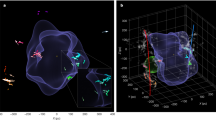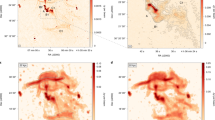Abstract
Theory predicts and observations confirm that low-mass stars (like the Sun) in their early life grow by accreting gas from the surrounding material. But for stars ∼10 times more massive than the Sun (∼10M⊙), the powerful stellar radiation is expected to inhibit accretion1 and thus limit the growth of their mass. Clearly, stars with masses >10M⊙ exist, so there must be a way for them to form. The problem may be solved by non-spherical accretion2,3, which allows some of the stellar photons to escape along the symmetry axis where the density is lower. The recent detection of rotating disks5,4,6 and toroids7 around very young massive stars has lent support to the idea that high-mass (≳8M⊙) stars could form in this way. Here we report observations of an ammonia line towards a high-mass star forming region. We conclude that the gas is falling inwards towards a very young star of ∼20M⊙, in line with theoretical predictions of non-spherical accretion.
This is a preview of subscription content, access via your institution
Access options
Subscribe to this journal
Receive 51 print issues and online access
$199.00 per year
only $3.90 per issue
Buy this article
- Purchase on Springer Link
- Instant access to full article PDF
Prices may be subject to local taxes which are calculated during checkout


Similar content being viewed by others
References
Kahn, F. D. Cocoons around early-type stars. Astron. Astrophys. 37, 149–162 (1974)
Yorke, H. W. & Sonnhalter, C. On the formation of massive stars. Astrophys. J. 569, 846–862 (2002)
Krumholz, M. R., McKee, C. F. & Klein, R. I. How protostellar outflows help massive stars form. Astrophys. J. 618, L33–L36 (2005)
Cesaroni, R. et al. A study of the Keplerian accretion disk and precessing outflow in the massive protostar IRAS 20126 + 4104. Astron. Astrophys. 434, 1039–1054 (2005)
Chini, R. et al. The formation of a massive protostar through the disk accretion of gas. Nature 429, 155–157 (2004)
Patel, N. et al. A disk of dust and molecular gas around a high-mass protostar. Nature 437, 109–111 (2005)
Beltrán, M. T. et al. Rotating disks in high-mass young stellar objects. Astrophys. J. 601, L187–L190 (2004)
Cesaroni, R., Felli, M., Testi, L., Walmsley, C. M. & Olmi, L. The disk-outflow system around the high-mass (proto)star IRAS 20126 + 4104. Astron. Astrophys. 325, 725–744 (1997)
Jiang, Z. et al. A circumstellar disk associated with a massive protostellar object. Nature 437, 112–115 (2005)
Cesaroni, R. in Massive Star Birth: A Crossroads of Astrophysics (eds Cesaroni, R., Felli, M., Churchwell, E. & Walmsley, M.) 59–69 (Proc. IAU Symp. 227, Cambridge Univ. Press, Cambridge, UK, 2005)
Cesaroni, R. Outflow, infall, and rotation in high-mass star forming regions. Astrophys. Space Sci. 295, 5–17 (2005)
Ho, P. T. P. & Haschick, A. D. Molecular clouds associated with compact H ii regions. III. Spin-up and collapse in the core of G10.6–0.4. Astrophys. J. 304, 501–514 (1986)
Keto, E. R., Ho, P. T. P. & Haschick, A. D. Temperature and density structure of the collapsing core of G10.6–0.4. Astrophys. J. 318, 712–728 (1987)
Zhang, Q. & Ho, P. T. P. Dynamical collapse in W51 massive cores: NH3 observations. Astrophys. J. 488, 241–257 (1997)
Hofner, P., Peterson, S. & Cesaroni, R. Ammonia absorption toward the ultracompact H ii regions G45.12 + 0.13 and G45.47 + 0.05. Astrophys. J. 514, 899–908 (1999)
Sollins, P. & Ho, P. T. P. The molecular accretion flow in G10.6–0.4. Astrophys. J. 630, 987–995 (2005)
Zhang, Q. in Massive Star Birth: A Crossroads of Astrophysics (eds Cesaroni, R., Felli, M., Churchwell, E. & Walmsley, M.) 135–144 (Proc. IAU Symp. 227, Cambridge Univ. Press, Cambridge, UK, 2005)
Codella, C., Testi, L. & Cesaroni, R. The molecular environment of H2O masers: VLA ammonia observations. Astron. Astrophys. 325, 282–294 (1997)
Furuya, R. S. et al. G24.78 + 0.08: A cluster of high-mass (proto)stars. Astron. Astrophys. 390, L1–L4 (2002)
Cesaroni, R., Codella, C., Furuya, R. S. & Testi, L. Anatomy of a high-mass star forming cloud: The G24.78 + 0.08 (proto)stellar cluster. Astron. Astrophys. 401, 227–242 (2003)
Beltrán, M. T. et al. A detailed study of the rotating toroids in G31.41 + 0.31 and G24.78 + 0.08. Astron. Astrophys. 435, 901–925 (2005)
Ungerechts, H., Winnewisser, G. & Walmsley, C. M. Ammonia observations and temperatures in the S140/L1204 molecular cloud. Astron. Astrophys. 157, 207–216 (1986)
Cesaroni, R., Churchwell, E., Hofner, P., Walmsley, C. M. & Kurtz, S. Hot ammonia towards compact H ii regions. Astron. Astrophys. 288, 903–920 (1994)
Walmsley, M. Dense cores in molecular clouds. Rev. Mex. Astron. Astrophys. Conf. Ser. 1, 137–148 (1995).
Keto, E. On the evolution of ultracompact H ii regions. Astrophys. J. 580, 980–986 (2002)
Wolfire, M. G. & Cassinelli, J. P. Conditions for the formation of massive stars. Astrophys. J. 319, 850–867 (1987)
Bonnell, I. A. & Bate, M. R. Binary systems and stellar mergers in massive star formation. Mon. Not. R. Astron. Soc. 362, 915–920 (2005)
McKee, C. F. & Tan, J. C. The formation of massive stars from turbulent cores. Astrophys. J. 585, 850–871 (2003)
McKee, C. F. & Tan, J. C. Massive star formation in 100,000 years from turbulent and pressurized molecular clouds. Nature 416, 59–61 (2002)
Bonnell, I. A., Vine, S. G. & Bate, M. R. Massive star formation: nurture, not nature. Mon. Not. R. Astron. Soc. 349, 735–741 (2004)
Acknowledgements
NRAO is operated by Associated University, Inc., under contract with the National Science Foundation. We thank P. Ho for suggestions that improved the presentation of our results.
Author information
Authors and Affiliations
Corresponding author
Ethics declarations
Competing interests
Reprints and permissions information is available at www.nature.com/reprints. The authors declare no competing financial interests.
Supplementary information
Supplementary Notes
This file provides a detailed derivation of the mass accretion rate and a discussion on the uncertainty of the value, and additional references. (PDF 50 kb)
Rights and permissions
About this article
Cite this article
Beltrán, M., Cesaroni, R., Codella, C. et al. Infall of gas as the formation mechanism of stars up to 20 times more massive than the Sun. Nature 443, 427–429 (2006). https://doi.org/10.1038/nature05074
Received:
Accepted:
Issue Date:
DOI: https://doi.org/10.1038/nature05074
This article is cited by
-
Accretion disks in luminous young stellar objects
The Astronomy and Astrophysics Review (2016)
-
Exact anisotropic sphere with polytropic equation of state
Pramana (2012)
Comments
By submitting a comment you agree to abide by our Terms and Community Guidelines. If you find something abusive or that does not comply with our terms or guidelines please flag it as inappropriate.



